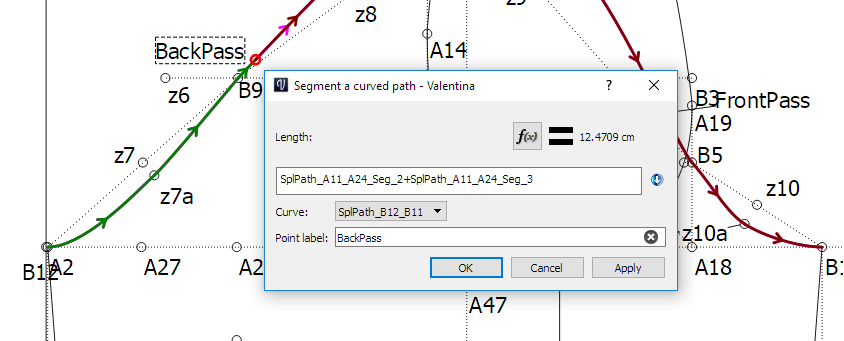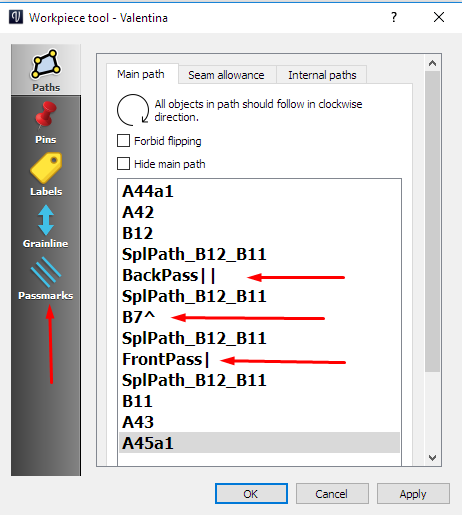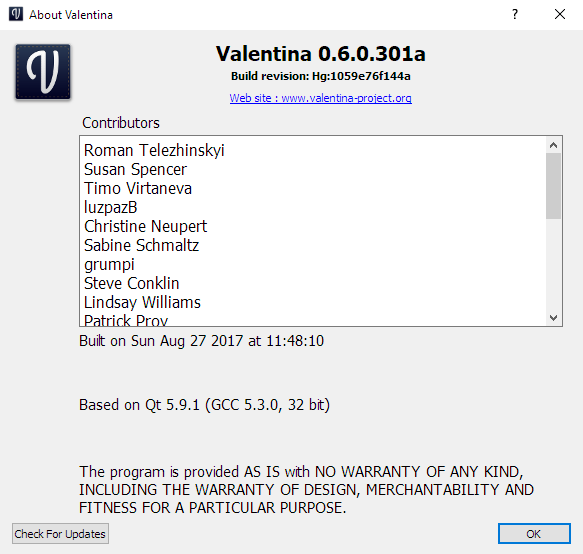Ahhh I know! So I need to minus the c1 radius by the difference between the new line and armhole in bodice block. If the value is 0.5cm, then the crown-C1 radius is bah-0.5.
Thank you very much for your help!
Ahhh I know! So I need to minus the c1 radius by the difference between the new line and armhole in bodice block. If the value is 0.5cm, then the crown-C1 radius is bah-0.5.
Thank you very much for your help!
Yes, your radius from the crown will be the (length of the armhole curve divided by whatever you divide it by)-0.5
And you’re very welcome 
One more thing! Now I want to trace the notch point. I have no problem with the front notch because the curve is already in clockwise direction. But how can I make the back notch point because I need to trace it in counterclockwise direction while I make the curve in clockwise direction. Maybe I can edit it first by making the back sleeve cap in counterclockwise, but is there another simpler way to do it?
Notches are called passpoints which are added to nodes by right-clicking on the node and selecting passpoint when you have created the detail and show in the seamline. You can edit the type of passmark on the right of the Options menu at the bottom.
I add a node at a specific distance from the armhole edge of the curve by using the segment a curve tool:


Because I’m still learning (or lazy) and am not too particular about sewing in ease stitches between the 2 notches, to fit the sleeve cap into the armhole of the bodice, I measure the notches from the armhole to the corresponding point on the bodice.
Ahh, I see, so I could measure it from the edge instead of the crown point. But then, my back sleeve cap is consisted of straight and curve line. Aside from measure it manually, is there any way to combine the measure of the overall line? Am I making any sense? Pardon my English.
@Grace i think there is not a way to measure entire length from edge to edge, including the curve. Do you know something I do not?
The best way I would know today is to artificially create a line with a formula. This is not the way the formula would look inside valentina but I hope it makes sense.
Use point at distance and angle tool. select ANY arbitrary point as origin Stretch the new line in ANY direction. Press enter to finish the creation.
Inside the dialog box that appears:
click on f(x) for the length.
Inside the “edit length” dialog box that appears, create your formula.
At that point you will have access to all of the length of lines and length of curves that exist and you can add them together. the result will be the length of your new line and valentina will do the math for you.
Do not add the line to any detail and change it to a color that does not offend you and ignore it.
I believe there is an existing issue to request a “ruler” line. The addition of curves to that should be added to the existing issue
Perhaps I’m not describing what I do very clearly. Firstly, I am working from Metric Pattern Cutting for Women which is available on Amazon: Amazon.com
I haven’t reached the point where the marking are created to match up the back armhole of the bodice with the back sleeve, so I have created my own markings, working off points on the curve of the back bodice and like-wise with the front bodice.
Here are my files if you’d like to see what I have done:
Lesson 1 - Bodice and Sleeve.val (63.2 KB) Aldrich Women - 8 to 18 - 32 to 42a.vst (2.3 KB)
Using this method, at least I know that the underarm part of the sleeve corresponds with the underarm part of the bodice.
Everyone will, in the end, develop their own methods, and I’m still developing mine.
Let’s assume the line extends from the end of the sleevecap. From the end of the curve (exclude the line) mark your passmark up the curve towards the crown at the distance you need minus the line length. If this is 0 or a negative number, then your notch will be at c1.
Alternative:
Start the curve from the end point of the sleevecap, and define it with a very long control handle to get the shape you want.
Reason:
The straight lines and curve offsets for drafting sleevecaps in manual paper-based patternmaking are there to create a starting place for the sleevecap curve. The patternmaker is expected to smooth and tweak this curve during the manual fitting adjustment after sewing the mockup or prototype.
Valentina/LibreFashion lets you skip those manual steps by calculating a fair smooth curve that matches the length of the armscye (plus a little bit of ease, unless you’re making a leather jacket or an overcoat.)
Ahh I see now! Thank you very much for all your help! 
Hallo, thank you for this treat, i am working at the same topic :slight_smile But i cannot open the Bodice and Sleece.val File, my system delivers only a source code as a .txt file, what is wrong there ? Thanks in advance Helga
I got a little confused when downloading test builds but I hope I’m using the correct one now:

I suggest downloading the latest test build from the link at the top of the page, install it and try again ![]()
I tried to open the bodice and sleeve.val, but it says: File error. Exception: Invalid version. Maximum supported version is 0.4.8.
My Valentina version is 0.5.0.1. Oh, one thing! If I update my software version, would I still be able to open and edit my previous files?
Yes, you would ![]()
I have updated Valentina, but the File "Lesson 1 - Bodice and Sleeve.val ist still a *.txt file, what have I to do to get the *.val File ? Thanks in advance Helga
If you can, please take a pic of which version Valentina you have installed now, like I did before, so I can see what version you’re on, please.
I’ve managed to save it as a .val file by opening the .txt file with notepad (I use Windows). Once the .txt file is open, go File, Save As, type in the name.val (or .vst), select File Type to . and click on Save.

Do this with both files. It worked for me.
Here are the files zipped up: Aldrich_Lesson_1.zip (8.4 KB)
Thank you very much, the zip-File works pretty good and the file is a good lesson for me Helga